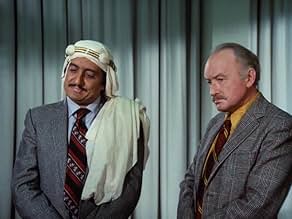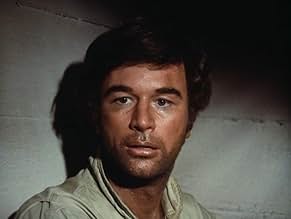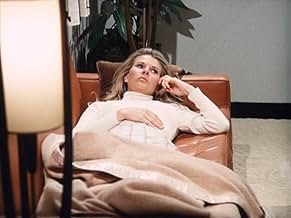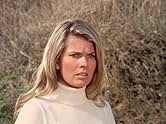L'homme qui valait trois milliards
Titre original : The Six Million Dollar Man
NOTE IMDb
6,9/10
5,4 k
MA NOTE
Ajouter une intrigue dans votre langueAfter an astronaut and test pilot is catastrophically mutilated in a test plane crash, he is rebuilt and equipped with nuclear powered bionic limbs and implants.After an astronaut and test pilot is catastrophically mutilated in a test plane crash, he is rebuilt and equipped with nuclear powered bionic limbs and implants.After an astronaut and test pilot is catastrophically mutilated in a test plane crash, he is rebuilt and equipped with nuclear powered bionic limbs and implants.
- Réalisation
- Scénario
- Casting principal
- Récompenses
- 1 nomination au total
Charles Robinson
- Prisoner
- (as Charles Knox Robinson)
George D. Wallace
- General
- (as George Wallace)
Olan Soule
- Saltillo
- (as Olan Soulé)
Claire Brennen
- OSI Committee Member
- (non crédité)
Eddie Garrett
- Security Guard outside Steve's room
- (non crédité)
Avis à la une
Just flicking through IMDB on a Monday evening, as you do, and have been stirred to write something through what can only be described as the apathy of others.
This show has only got ONE comment. (You're not supposed to comment on the other folk's remarks, but I'm not doing that, I'm writing to complain about the near absence of feedback, and the other writer thought it cool too).
Can anyone reading this please offer their opinion. I attended school in the seventies when this show was originally aired, and have fond memories of it. Later in life I spent many years travelling and working throughout the world and in the classic scene of many different nationalities coming together in the evening over a bottle of wine, few beers etc this show was one of the highlights of conversation. Surely people must remember back with glee the exploits of Steve Austin and his bionic implants. There was a time when a whole peer group (myself included) wanted to train as astronauts just to come a cropper at some point in order to be dragged out of the smouldering wreckage so we may be rebuilt in the new, improved style. That's what seventies youngsters dreamt of; embodying new technology in a personal and pretty literal way. I remember the start:- Steve Austin, a man barely alive. We can rebuild him.
Better.
Stronger.
Faster.
It's a pity other people can't remember a little and perhaps write a bit more. Please get in touch.
This show has only got ONE comment. (You're not supposed to comment on the other folk's remarks, but I'm not doing that, I'm writing to complain about the near absence of feedback, and the other writer thought it cool too).
Can anyone reading this please offer their opinion. I attended school in the seventies when this show was originally aired, and have fond memories of it. Later in life I spent many years travelling and working throughout the world and in the classic scene of many different nationalities coming together in the evening over a bottle of wine, few beers etc this show was one of the highlights of conversation. Surely people must remember back with glee the exploits of Steve Austin and his bionic implants. There was a time when a whole peer group (myself included) wanted to train as astronauts just to come a cropper at some point in order to be dragged out of the smouldering wreckage so we may be rebuilt in the new, improved style. That's what seventies youngsters dreamt of; embodying new technology in a personal and pretty literal way. I remember the start:- Steve Austin, a man barely alive. We can rebuild him.
Better.
Stronger.
Faster.
It's a pity other people can't remember a little and perhaps write a bit more. Please get in touch.
The TV movie that led to "The Six Million Dollar Man" becoming one of the biggest hits of the 1970s, and being fondly remembered by many who were the right age at the time (not least me - I still remember playing with my Steve Austin doll), is strikingly different from what would come. Admittedly the series was hardly a laugh riot, but the source was even straighter, with nothing to indicate that Col. Austin would eventually acquire a bionic girlfriend (and dog) and meet the likes of Bigfoot, a double, and alien killer machines. (We won't mention that "Sweet Jaime" song.)
Not only does Henri Simoun's teleplay furnish our hero with some actual doubt over how much of a human being he is now, but the relationship between him and his superior officer is less chummy - no benevolent Oscar Goldman of the OSI here, instead the OSO's colder Spencer (Darren McGavin, easily taking the acting honours). Plus, when Steve is eventually sent into the field, it's surprisingly straightforward - the movie emphasises drama over derring-do (note the lack of DANANANANANANA sound effects). This isn't always for the best; the actual crash isn't as effective as it could have been, and 30 years on some elements have dated somewhat - who'd be so casual about a nuclear-powered motor today? - but if ultimately it's not as much fun as the series, it's also a bit more thoughtful.
Footnotes: This movie was edited into two parts and shown on the series as "The Moon And The Desert." More importantly, no one here calls him "a man barely alive," let alone says "We can rebuild him" or "We have the technology."
Not only does Henri Simoun's teleplay furnish our hero with some actual doubt over how much of a human being he is now, but the relationship between him and his superior officer is less chummy - no benevolent Oscar Goldman of the OSI here, instead the OSO's colder Spencer (Darren McGavin, easily taking the acting honours). Plus, when Steve is eventually sent into the field, it's surprisingly straightforward - the movie emphasises drama over derring-do (note the lack of DANANANANANANA sound effects). This isn't always for the best; the actual crash isn't as effective as it could have been, and 30 years on some elements have dated somewhat - who'd be so casual about a nuclear-powered motor today? - but if ultimately it's not as much fun as the series, it's also a bit more thoughtful.
Footnotes: This movie was edited into two parts and shown on the series as "The Moon And The Desert." More importantly, no one here calls him "a man barely alive," let alone says "We can rebuild him" or "We have the technology."
I just watched a show on the History Channel talking about Star trek tech and how it inspired scientists and engineers or got then interested in science. It would be interesting to see The History Channel do The same for TSMDM and show bionic tech and talk to doctors and engineers who were inspired by the show to create real bionic arms legs and eyes or the doctors who treat patients with artificial limbs and eyes and ears. In fact I just remembered an episode when Doctor Rudy Wells created a bionic heart used to transplant into some important world leader who if he died would leave a power vacuum which would lead to disaster
Colonel Steve Austin, astronaut and test pilot, is badly injured when he crashes while testing an experimental aircraft. A covert government agency (OSI) is willing to pay for special prosthetics to replace the eye, arm and both legs he lost in the crash. Highly advanced technology (bionics) built into them will make him faster, stronger and more resilient than normal. In return they want him to become a covert agent for the OSI. It will cost $6,000,000 to rebuild Steve Austin.
And build him they do, but the lead up to Steve getting rebuilt is thoughtfully done with Lee Majors expressing anguish over his injuries, even suicidal, and Oscar ( here played by Darren McGavin) is a much colder character who expects Austin to push himself to the limit in his new robotic get-up. It's a solid pilot to a great series, is quite serious, introspective and intelligent.
And build him they do, but the lead up to Steve getting rebuilt is thoughtfully done with Lee Majors expressing anguish over his injuries, even suicidal, and Oscar ( here played by Darren McGavin) is a much colder character who expects Austin to push himself to the limit in his new robotic get-up. It's a solid pilot to a great series, is quite serious, introspective and intelligent.
Even it didn't introduction one of the most iconic fictional characters of all time this would stand up as a great movie. However, since it does introduce Steve Austin (one of TV's best-ever characters and greatest superheroes), this raises it up to be something truly special. Watching it is something akin to a spiritual experience. Trying to write an impartial review is next to impossible, since I love every second of this thing with passion. But I'll have a go.
Tight pace. The opening minutes show two men in parallel: a pilot called Steve Austin who is about to test a new type of plane, and very serious government official who is proposing a new type of soldier/spy to a room of very stuffy and self-important people. As we move into the second quarter of the movie, Austin has been mutilated in a crash and is being kept alive by machines. His suffering is succinctly brought across in several short/ingenious scenes. The mid-section of the movie shows us the new Austin: rebuilt by science and trying to master his new limbs. By the time we enter the final quarter of the movie, Steve is fully in control of his new body parts and we see him start to use them: first to save a boy in a traffic accident, and then on his first mission.
Lee Majors. In one of the great marriages between character and actor, Majors takes the reins of Austin and makes him his own. Right from the first moment he saunters into shot Steve Austin is a likable hero: a very real, very human superhero. There are corny moments (like Steve addressing the entire flight crew by first name and seeming to know all about them) but Majors sells everything in the script. And adds to it. Two minutes into the movie, 50% of the guys watching will want to invite Austin for a few beers on the town and the other half will wish they were Austin. When the action gets dramatic (Austin trying to end his pathetic life, or - later - examining his own right arm) Majors is 100% committed to the role and he's make you feel everything Steve does.
Cleverness. The movie is clever, and subtle, in ways that the (wonderful) TV series never tried to be. The man who orders the rebuilding of Austin walks with a cane. He is also heartless and - because of this - is more of a robot than Austin will ever be. The storytelling is wonderfully subtle in other ways, too. As Austin is told of his accident, the camera cuts away and we see/hear the reaction of the heart monitor. The sound, I suppose, of a breaking heart. And, later in the story, as Austin is on the verge of giving that heart to the pretty young nurse that has fallen in love with him, the story takes another unexpected turn: Austin orders her off the case and she overhears. We expect that she will run away in tears. Instead, she confronts Austin and calmly states her case. She doesn't behave like a 'tv character', she behaves like a real woman. It's the character's best scene. Finally, the mission that Steve goes on is not quite what it appears to be. Clever scripting makes everything, and everyone, shades of grey and makes the entire story more enjoyable.
Casting. Darren McGavin almost steals the movie from Majors with a truly fascinating portrayal of the man who orders the rebuilding. Martin Balsam and Barbara Anderson round out the cast and each one gets scene after scene of quality material.
Continuity. The three movies that started the SMDM series are an oddity. None of them really fits in with the continuity of the series. (In a nice bit of symmetry, the three movies that ended the series are exactly the same: Part of the franchise, but not quite...) Cyborg has many elements that are exactly the same as the series. The character of Steve Austin is consistent, even if his rank/status within the Air Force is not the same. Rudy Wells, the doctor that saves Steve and makes him bionic is also exactly as you will find him in the television series. It's a different character, yes, but he has the same heart and intelligent. He has the same bond with Steve, too. But there are many elements that are not even close to the TV series. Instead of beloved Oscar Goldman, we get a hard-nosed bastard called Oliver Spencer calling the shots. This guy sees Steve as a weapon. Nothing more. In the episodes that followed, many scripts made it clear that there was a very strong bond/friendship between Steve and his so-called boss. Some episodes made them seem like partners working side-by-side, and most episodes made it clear that they loved one another as only best friends can. It's fascinating to see what direction the show could have taken. Fascinating, but not better. Then there is the lover. She disappears after this and is never mentioned again (though the series does introduce a similar character at one point). We can presume that Nurse Jean got over her infatuation and she and Steve called it quits. There are other things, too. Minor things, mostly, like the name of the OSI being something different. Things that mean, if you want to look at it this way, that the events of this story take place in a parallel universe.
Or something.
I don't care.
It's a superb movie. It captured my imagination when I first saw it, as a child, and it still has a firm grip on my imagination (and my heart) all these years later.
http://yetanothertvreviewpodcast.blogspot.com/
Tight pace. The opening minutes show two men in parallel: a pilot called Steve Austin who is about to test a new type of plane, and very serious government official who is proposing a new type of soldier/spy to a room of very stuffy and self-important people. As we move into the second quarter of the movie, Austin has been mutilated in a crash and is being kept alive by machines. His suffering is succinctly brought across in several short/ingenious scenes. The mid-section of the movie shows us the new Austin: rebuilt by science and trying to master his new limbs. By the time we enter the final quarter of the movie, Steve is fully in control of his new body parts and we see him start to use them: first to save a boy in a traffic accident, and then on his first mission.
Lee Majors. In one of the great marriages between character and actor, Majors takes the reins of Austin and makes him his own. Right from the first moment he saunters into shot Steve Austin is a likable hero: a very real, very human superhero. There are corny moments (like Steve addressing the entire flight crew by first name and seeming to know all about them) but Majors sells everything in the script. And adds to it. Two minutes into the movie, 50% of the guys watching will want to invite Austin for a few beers on the town and the other half will wish they were Austin. When the action gets dramatic (Austin trying to end his pathetic life, or - later - examining his own right arm) Majors is 100% committed to the role and he's make you feel everything Steve does.
Cleverness. The movie is clever, and subtle, in ways that the (wonderful) TV series never tried to be. The man who orders the rebuilding of Austin walks with a cane. He is also heartless and - because of this - is more of a robot than Austin will ever be. The storytelling is wonderfully subtle in other ways, too. As Austin is told of his accident, the camera cuts away and we see/hear the reaction of the heart monitor. The sound, I suppose, of a breaking heart. And, later in the story, as Austin is on the verge of giving that heart to the pretty young nurse that has fallen in love with him, the story takes another unexpected turn: Austin orders her off the case and she overhears. We expect that she will run away in tears. Instead, she confronts Austin and calmly states her case. She doesn't behave like a 'tv character', she behaves like a real woman. It's the character's best scene. Finally, the mission that Steve goes on is not quite what it appears to be. Clever scripting makes everything, and everyone, shades of grey and makes the entire story more enjoyable.
Casting. Darren McGavin almost steals the movie from Majors with a truly fascinating portrayal of the man who orders the rebuilding. Martin Balsam and Barbara Anderson round out the cast and each one gets scene after scene of quality material.
Continuity. The three movies that started the SMDM series are an oddity. None of them really fits in with the continuity of the series. (In a nice bit of symmetry, the three movies that ended the series are exactly the same: Part of the franchise, but not quite...) Cyborg has many elements that are exactly the same as the series. The character of Steve Austin is consistent, even if his rank/status within the Air Force is not the same. Rudy Wells, the doctor that saves Steve and makes him bionic is also exactly as you will find him in the television series. It's a different character, yes, but he has the same heart and intelligent. He has the same bond with Steve, too. But there are many elements that are not even close to the TV series. Instead of beloved Oscar Goldman, we get a hard-nosed bastard called Oliver Spencer calling the shots. This guy sees Steve as a weapon. Nothing more. In the episodes that followed, many scripts made it clear that there was a very strong bond/friendship between Steve and his so-called boss. Some episodes made them seem like partners working side-by-side, and most episodes made it clear that they loved one another as only best friends can. It's fascinating to see what direction the show could have taken. Fascinating, but not better. Then there is the lover. She disappears after this and is never mentioned again (though the series does introduce a similar character at one point). We can presume that Nurse Jean got over her infatuation and she and Steve called it quits. There are other things, too. Minor things, mostly, like the name of the OSI being something different. Things that mean, if you want to look at it this way, that the events of this story take place in a parallel universe.
Or something.
I don't care.
It's a superb movie. It captured my imagination when I first saw it, as a child, and it still has a firm grip on my imagination (and my heart) all these years later.
http://yetanothertvreviewpodcast.blogspot.com/
Le saviez-vous
- AnecdotesDuring the opening sequence of the show, the crash shown is actual footage of a crash of the M2-F2 experimental lifting body that was part of the research that eventually led to the development of the space shuttle.
- GaffesThe "Factual Error" that Austin's human left arm should have been amputated to prevent incompatible balance produces an enormous character error if such had occurred. The friendship that is demonstrated between Austin and Dr. Wells would never allow the latter to amputate a healthy arm of his friend, whether it would be mechanically efficient or not. Further, Dr. Wells is portrayed as the kind of man not to violate his Hippocratic oath of "Do no harm" which such an amputation would be in contrast to.
- Citations
Steve Austin: Yes sir?
General: Have you any idea what time it is?
Steve Austin: [looks up at the sky] About five to seven?
- Versions alternativesRe-edited into two episodes of "The Six Million Dollar Man" for syndication. To pad out the story, scenes were added from The Bionic Woman (1975), The Bionic Boy (1976) and Dark Side of the Moon: Part 1 (1977).
- ConnexionsEdited from Vol perdu (1970)
Meilleurs choix
Connectez-vous pour évaluer et suivre la liste de favoris afin de recevoir des recommandations personnalisées
Détails
- Durée1 heure 15 minutes
- Mixage
- Rapport de forme
- 1.33 : 1
Contribuer à cette page
Suggérer une modification ou ajouter du contenu manquant
































